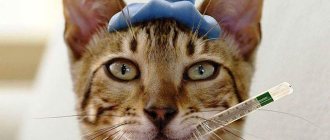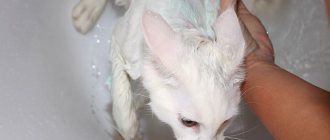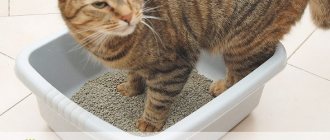Home » Useful Information
Fever in cats can be caused by various reasons, which must be diagnosed. If there is a fever, the pet's condition worsens, which requires immediate action. To reduce the temperature, you can use a set of home remedies, as well as give the animal medications prescribed by the doctor.
- 2 Causes of fever in pets
- 3 Additional symptoms
- 4 How to determine the temperature of an animal
4.1 Video: how to measure a pet’s temperature
- 5.1 Traditional methods
What temperature is considered normal for cats?
The temperature in cats, unlike in humans, is considered normal in the range from 37.8 to 39 degrees. Higher values indicate a pathological process or overheating of the body. An increase in temperature cannot be ignored, as the cause may be a serious pathology.
Normally, a cat’s body is designed in such a way that excess heat is eliminated naturally through the skin and respiratory system. If the pet is sick, then this process of thermoregulation is disrupted.
A cat's normal body temperature is ensured by the body's natural thermoregulation.
Normal temperature values are the same for all breeds. In hairless cats, the average values also do not change.
Prevention
To prevent your pet from getting sick with viral and infectious diseases that provoke a rise in temperature, as well as many other unpleasant problems, you need to act according to the following scheme:
- Feed your animal correctly - the food should be nourishing, healthy and balanced; do not feed your cat from the table, as such food does not have any benefit for them.
- Vaccination - vaccinations and annual vaccinations can protect your animal from many dangerous ailments.
- Lack of self-walking - some animals are simply not created to live indoors, in which case they need to be trained to walk within the yard. This way, you will protect your pet from possible contact with other unvaccinated animals.
- Overheating - if you transport your animal in a car during the hot season, then do not leave it inside. You can’t imagine what kind of overload the cat’s body endures while you go to the store for 10 minutes.
Owners need to remember that temperature is a serious symptom that signals that not everything is ok with your pet’s condition. Under no circumstances resort to dubious methods of self-medication.
Animals are not able to help themselves in this state. Go to an appointment with a qualified veterinarian and only then can you be sure that your pet will definitely recover.
Causes of fever in pets
When the body overheats and is stressed, the cat’s body temperature does not exceed 40 degrees. In most cases, the cause of fever can be a viral or bacterial infection that occurs in an acute form. The chronic course of pathologies is rarely accompanied by an increase in temperature. Disturbances in thermoregulation can be caused by toxins that accumulate in the body in the presence of parasites, protozoa and bacterial flora.
A cat's temperature often rises when there is a bacterial or viral infection.
The following diseases and pathological conditions contribute to an increase in temperature (hyperthermia):
- inflammatory pathologies of the ENT organs: otitis media;
- bronchitis;
- pneumonia;
- cystitis;
Processes of necrosis (death) of tissues in the body can also provoke an elevated temperature in an animal, so if there is a fever, it is necessary to show your pet to a veterinarian.
Possible complications and their elimination
Hyperthermia does not always end with just a trip to the doctor. Sometimes it is fraught with serious consequences, various types of organ disorders. Heatstroke in cats leads to gastrointestinal disorders, disruption of the functioning of the cardiovascular, musculoskeletal, urinary, and nervous systems.
Healthy adults are able to recover on their own, but older cats, small kittens and animals with chronic diseases cannot cope. They need a thorough veterinary examination and treatment.
Even if the cat is apparently healthy, do not take risks and see a veterinarian. The consequences of heatstroke in cats can be fatal!
Additional symptoms
Fever in pets is often accompanied by apathy, lack of activity and decreased appetite. The animal may even refuse water and spend most of its time lying on its side. At the same time, the cat often hides from its owner in a secluded place where no one will disturb it:
- If your pet additionally has diarrhea and vomiting, this may indicate food poisoning or acute gastrointestinal diseases: ulcers, pancreatitis and liver damage. In this case, tachycardia may also occur, the animal’s fur loses its shine and falls off.
When the temperature rises, the pet often experiences apathy and lack of appetite.
- If the pet does not allow you to touch its belly and reacts to any attempt with a plaintive meow or aggression, then this behavior indicates pathologies of the abdominal cavity.
- When the temperature rises, you need to examine your pet’s skin. In the presence of sores, wounds and rashes, tick-borne encephalitis, lichen or severe allergic reactions can be suspected.
If the animal refuses water, it is important to immediately consult a doctor, as dehydration can cause death. This is especially necessary if the fever is accompanied by diarrhea.
How to determine an animal's temperature
An indicator of an increase in a cat's body temperature is the nose. If it is cool and damp, then the pet is healthy. A warm and dry nose indicates hyperthermia. However, this method does not make it possible to determine accurate data. In order to measure the animal's temperature, you will need a mercury or electronic thermometer.
A cat may have a dry and warm nose, for example, after sleep. But this does not mean the pet is unhealthy. This sign should be considered in conjunction with other symptoms.
First of all, you need to prepare any available tool that will help you easily and painlessly insert the thermometer into the rectum. This could be Levomekol ointment, Vaseline or baby cream. Before the procedure, the pet should be carefully secured by wrapping it in a towel. It is good if someone helps, since it is difficult to do this on your own, especially when the cat is aggressive.
To measure temperature, you can use either an electronic or a mercury thermometer
After fixing, the tip of the thermometer must be lubricated with any of the listed products and carefully inserted into the animal’s anus to a depth of no more than 1 cm. If we are talking about a standard mercury thermometer, then you will have to wait from three to five minutes. Electronic thermometers cope with the task faster. After measuring the temperature, the device must be carefully removed from the rectum.
Measuring a cat's body temperature is done rectally
You need to insert the thermometer evenly and smoothly; such actions will avoid injury to the rectum.
Video: how to measure a pet's temperature
Raised by the street
The same measures are taken when the pet lives in the yard. If the dog is sitting on a chain or in an enclosure, the kennel should be moved to the shade and, if possible, provided with ventilation. A muzzle should not be used, as it interferes with heat transfer. When free-ranging, dogs and cats usually find drafts and cool places on their own.
It's not just homes that are battling the heat, but shelters as well. Daria Meshcheryakova, coordinator of the AlabaiHelp team, told Izvestia about the forced changes.
Water for cats
Photo: RIA Novosti/Grigory Sysoev
— The walking schedule has been changed: volunteer walks are cancelled, only employees walk, quickly “on business.” But with nutrition, everything is individual, some dogs are stomachs on legs that eat well in any weather,” Daria shared. — Of course, we try to help our charges. Throughout the day we water the enclosures, plus there are trees on the territory, each dog has a shade.
The work of a drowning man: how to swim and stay alive
The beginning of the swimming season was marked by a series of tragedies on the water
Due to the heat, the Murkosha cat shelter had to purchase new equipment.
— Our shelter has portable air conditioners. At the moment, we are purchasing four additional ones, since the temperature outside is breaking all records,” said the head of the PR department, Yanna Serkova. — We can also help pets with thermoregulation by placing damp, thin beds under their paws.
What can you do at home?
If the temperature rises slightly, it is not necessary to take any measures, but even this does not cancel a trip to the doctor. If your cat has a high fever, you can use echinacea tincture, which stimulates the body's defenses. There should be 1 ml of medicine per 1 kg of weight:
- The required amount of tincture should be mixed with boiled water (1 tbsp.).
- Draw the liquid into a syringe without a needle and forcefully give it to your pet.
- It is not recommended to use the product more than once a day.
Echinacea tincture stimulates the immune system
Additionally, you can use Regidron solution, which will replenish the fluid deficiency in your pet’s body and improve its well-being by preventing dehydration. 1 sachet needs to be filled with 1 liter of water and mixed thoroughly. The solution should be given 20 ml 3-4 times a day forcibly.
Rehydron replenishes fluid deficiency in the body
To reduce your pet's body temperature, it is not recommended to give non-steroidal anti-inflammatory medications: Ibuprofen, Nurofen, Diclofenac, etc. Such drugs can cause bleeding from the gastrointestinal tract, especially when taken on an empty stomach.
One day my cat got sick, which I identified by its characteristic signs. Kesha did not get up, and his nose was warm. In this case, due to lack of experience, I turned to my neighbor, an avid cat lover. In front of me, she measured the pet’s temperature by inserting a mercury thermometer into his anus. As it turned out, my pet had a fever, the cause of which was inflammation of the kidneys, which was clear from the animal sitting on the tray for a long time. In this case, treatment was carried out with antibacterial drugs prescribed by the veterinarian. Soon the cat felt much better, he began to play and run.
Traditional methods
To reduce your pet's temperature, you can use cool water to wet the animal's paws. However, you should never bathe a cat while sick. Cool water should be used not only externally, but also given to the pet internally using a syringe every few hours, 10-20 ml to prevent dangerous consequences.
If the temperature is close to 41 degrees, then it is recommended to wipe the cat’s paw pads with vodka or alcohol (it should be diluted half with water) every hour. For the same purposes, you can use 4% apple cider vinegar diluted with water 1:1. This procedure will ease the animal’s condition and help lower the temperature slightly.
Apple cider vinegar can be used to wipe your pet's paws
In extreme heat, you can apply ice wrapped in a towel to your pet's body, avoiding the abdominal area. This product should only be used urgently. It is not recommended to use it regularly. To alleviate your pet’s condition, you can turn on the air conditioning, but only to reduce the temperature in the room by a few degrees.
Some cat breeders recommend massage to relieve fever. It is necessary to feel the area under the knee bend on the outside of the hind paw. Then massage this area for 5 minutes. This area is responsible for thermoregulation and will slightly reduce the manifestations of heat.
Video: what to do if your pet has a fever
When to contact a veterinarian
If your pet's temperature is 41 degrees, it is important to consult a doctor immediately. You can’t hesitate, otherwise the consequences can be very sad. In addition, consultation with a specialist is also important in the case when a cat has a temperature of 40 degrees, but lasts for more than a day. Immediate hospitalization is needed for fever, which is accompanied by vomiting and diarrhea. In this case, dehydration can occur in the shortest possible time and cause death.
In a clinical setting, a doctor is able to identify the cause. For these purposes, the veterinarian takes blood from the animal’s vein and also examines the skin. To eliminate bacterial and viral infections, the doctor prescribes antibiotics and immunostimulants. The most effective way to administer the medicine is by injection. It allows you to quickly eliminate the source of infection and bring down the temperature. The following are often used for therapy:
Sinulox is used to eliminate bacterial infections
To eliminate a viral infection, the following is prescribed:
These drugs stimulate the body's defenses, promoting the activation of T-lymphocytes, which inhibit the proliferation of viral particles. At the end of the course of treatment, vitamin complexes and various feed additives are prescribed to speed up recovery.
Gamavit stimulates the immune system and allows you to quickly relieve your cat of fever
To reduce the temperature provoked by a severe allergic reaction, intramuscular injections of Dexamethasone are used. The dose and course of treatment are determined by the doctor depending on the severity of the symptoms. Glucocorticosteroids during fever are often administered once, as these drugs can also provoke undesirable reactions.
Dexamethasone is used to relieve allergies and fever
In rare cases, a cat is prescribed Analgin in combination with Diphenhydramine at a temperature that exceeds 41 degrees. In this case, both solutions are mixed and administered intramuscularly. Per 1 kg of weight there should be 0.01 mg of Diphenhydramine and 0.05 mg of Analgin. However, in each case, the dosage is determined by the doctor. It is not recommended to give such medications on your own.
Analgin has an analgesic and antipyretic effect
The course of treatment at high temperatures can range from 5 to 7 days, depending on the nature of the provoking factor. Viral infections require longer treatment than bacterial infections.
Giving your cat acetylsalicylic acid and paracetamol during fever is prohibited.
An increase in body temperature in cats should alert owners, as this may be a sign of a serious pathology. Home remedies can be used in combination with medication to relieve fever. However, drug therapy is not recommended without prior consultation with a doctor.











